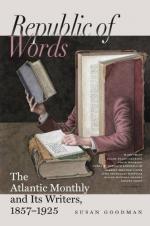“laughing
leaves
That Franco of Bologna’s
pencil limned “;
but the line of those artists ended with Fra Angelico, whose works are only larger illuminations in fresco and on panel. In those days some precious volume became the Laura of a poor monk, who lavished on it all the poetry of his nature, all the unsatisfied longing of a lifetime. Shut out from the world, his single poem or book of saintly legends was the window through which he looked back on real life, and he stained its panes with every brightest hue of fancy and tender half-tint of reverie. There was, indeed, a chance of success, when the artist worked for the love of it, gave his whole manhood to a single volume, and mixed his life with his pigments. But to please yourself is a different thing from pleasing Tom, Dick, and Harry, which is the problem to be worked out by whoever makes illustrations to be multiplied and sold by thousands. In Dr. Palmer’s “Folk-Songs,” if we understand his preface rightly, the artists have done their work for love, and it is accordingly much better done than usual. The engravings make a part of the page, and the designs, with few exceptions, are happy. Numerous fac-similes of handwriting are added for the lovers of autographs; and in point of printing, it is beyond a question the handsomest and most tasteful volume ever produced in America. The Riverside Press may fairly take rank now with the classic names in the history of the art. But it is for the judgment shown in the choice of the poems that the book deserves its chief commendation. Our readers do not need to be told who Dr. Palmer is, or that one who knows how to write so well himself is likely to know what good writing is in others. We have never seen so good and choice a florilegium. The width of its range and its catholicity may be estimated by its including William Blake and Dibdin, Bishop King and Dr. Maginn. It would be hard to find the person who would not meet here a favorite poem. We can speak from our own knowledge of the length of labor and the loving care that have been devoted to it, and the result is a gift-book unique in its way and suited to all seasons and all tastes. Nor has the binding (an art in which America is far behind-hand) been forgotten. The same taste makes itself felt here, and Matthews of New York has seconded it with his admirable workmanship.
In Mr. Stoddard’s volume we have a poet selecting such poems as illustrate the loves of the poets. It is a happy thought happily realized. With the exception of Dante, Petrarch, and Tasso, the choice is made from English poets, and comes down to our own time. It is a book for lovers, and he must be exacting who cannot find his mistress somewhere between the covers. The selection from the poets of the Elizabethan and Jacobian periods is particularly full; and this is as it should be; for at no time was our language more equally removed from conventionalism and commonplace, or so fitted to refine strength of passion with recondite thought and airy courtliness of phrase. The book is one likely to teach as well as to please; for, though everybody knows how to fall in love, few know how to love. It is a mirror of womanly loveliness and manly devotion. Mr. Stoddard has done his work with the instinct of a poet, and we cordially commend his truly precious volume both to those




